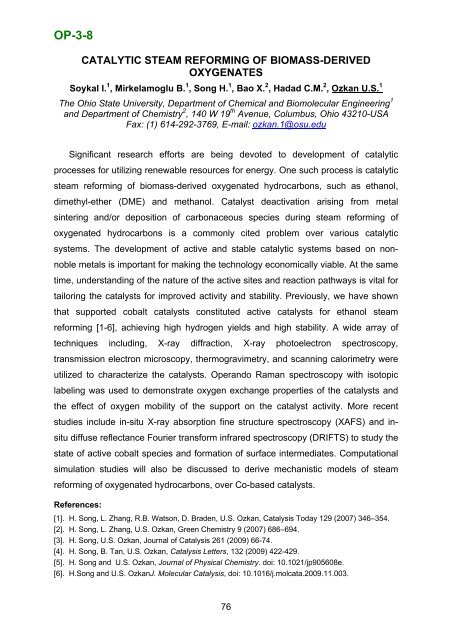Boreskov Institute of Catalysis SB RAS, Novosibirsk, Russia
Boreskov Institute of Catalysis SB RAS, Novosibirsk, Russia
Boreskov Institute of Catalysis SB RAS, Novosibirsk, Russia
- No tags were found...
You also want an ePaper? Increase the reach of your titles
YUMPU automatically turns print PDFs into web optimized ePapers that Google loves.
OP-3-8CATALYTIC STEAM REFORMING OF BIOMASS-DERIVEDOXYGENATESSoykal I. 1 , Mirkelamoglu B. 1 , Song H. 1 , Bao X. 2 , Hadad C.M. 2 , Ozkan U.S. 1The Ohio State University, Department <strong>of</strong> Chemical and Biomolecular Engineering 1and Department <strong>of</strong> Chemistry 2 , 140 W 19 th Avenue, Columbus, Ohio 43210-USAFax: (1) 614-292-3769, E-mail: ozkan.1@osu.eduSignificant research efforts are being devoted to development <strong>of</strong> catalyticprocesses for utilizing renewable resources for energy. One such process is catalyticsteam reforming <strong>of</strong> biomass-derived oxygenated hydrocarbons, such as ethanol,dimethyl-ether (DME) and methanol. Catalyst deactivation arising from metalsintering and/or deposition <strong>of</strong> carbonaceous species during steam reforming <strong>of</strong>oxygenated hydrocarbons is a commonly cited problem over various catalyticsystems. The development <strong>of</strong> active and stable catalytic systems based on nonnoblemetals is important for making the technology economically viable. At the sametime, understanding <strong>of</strong> the nature <strong>of</strong> the active sites and reaction pathways is vital fortailoring the catalysts for improved activity and stability. Previously, we have shownthat supported cobalt catalysts constituted active catalysts for ethanol steamreforming [1-6], achieving high hydrogen yields and high stability. A wide array <strong>of</strong>techniques including, X-ray diffraction, X-ray photoelectron spectroscopy,transmission electron microscopy, thermogravimetry, and scanning calorimetry wereutilized to characterize the catalysts. Operando Raman spectroscopy with isotopiclabeling was used to demonstrate oxygen exchange properties <strong>of</strong> the catalysts andthe effect <strong>of</strong> oxygen mobility <strong>of</strong> the support on the catalyst activity. More recentstudies include in-situ X-ray absorption fine structure spectroscopy (XAFS) and insitudiffuse reflectance Fourier transform infrared spectroscopy (DRIFTS) to study thestate <strong>of</strong> active cobalt species and formation <strong>of</strong> surface intermediates. Computationalsimulation studies will also be discussed to derive mechanistic models <strong>of</strong> steamreforming <strong>of</strong> oxygenated hydrocarbons, over Co-based catalysts.References:[1]. H. Song, L. Zhang, R.B. Watson, D. Braden, U.S. Ozkan, <strong>Catalysis</strong> Today 129 (2007) 346–354.[2]. H. Song, L. Zhang, U.S. Ozkan, Green Chemistry 9 (2007) 686–694.[3]. H. Song, U.S. Ozkan, Journal <strong>of</strong> <strong>Catalysis</strong> 261 (2009) 66-74.[4]. H. Song, B. Tan, U.S. Ozkan, <strong>Catalysis</strong> Letters, 132 (2009) 422-429.[5]. H. Song and U.S. Ozkan, Journal <strong>of</strong> Physical Chemistry. doi: 10.1021/jp905608e.[6]. H.Song and U.S. OzkanJ. Molecular <strong>Catalysis</strong>, doi: 10.1016/j.molcata.2009.11.003.76
















